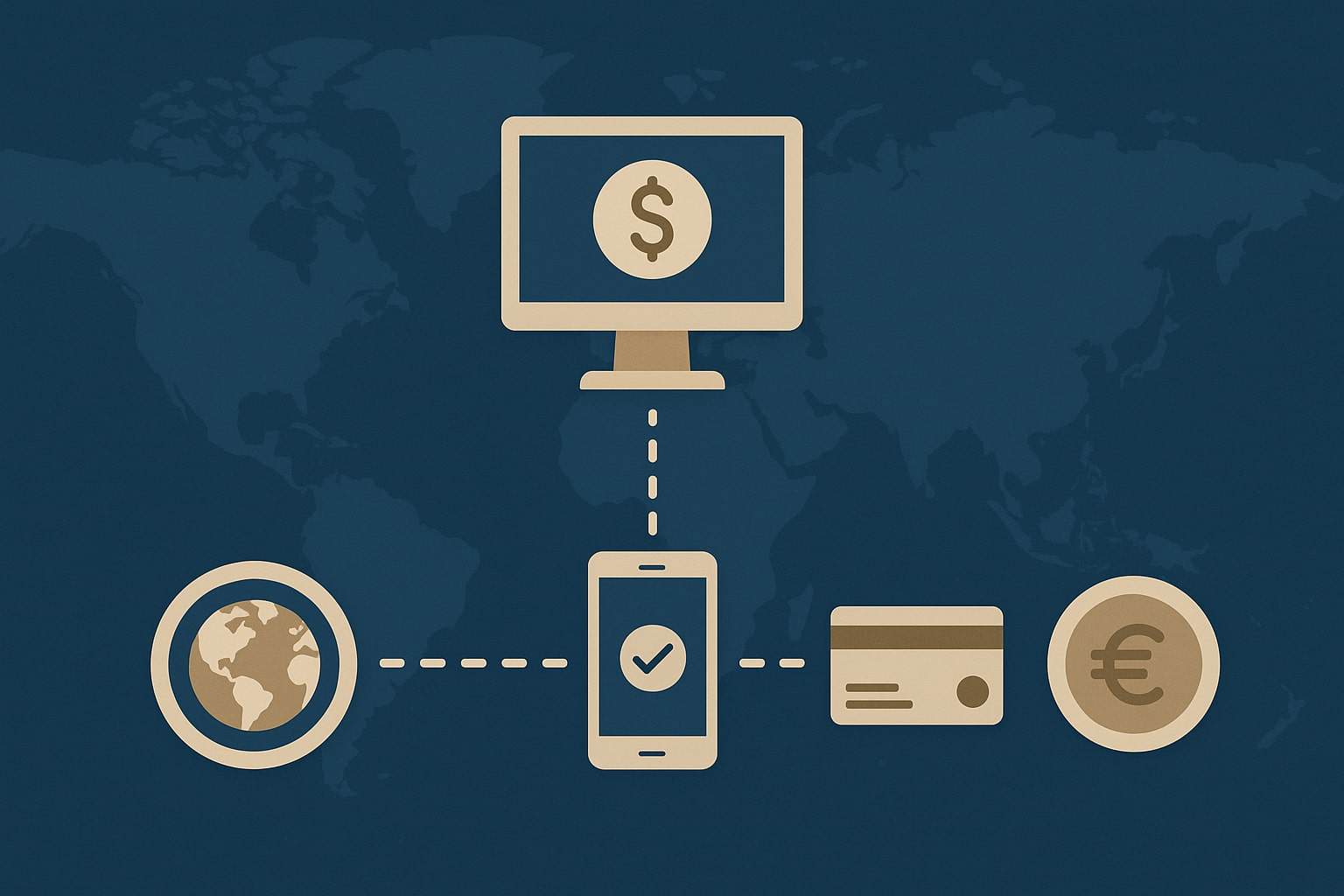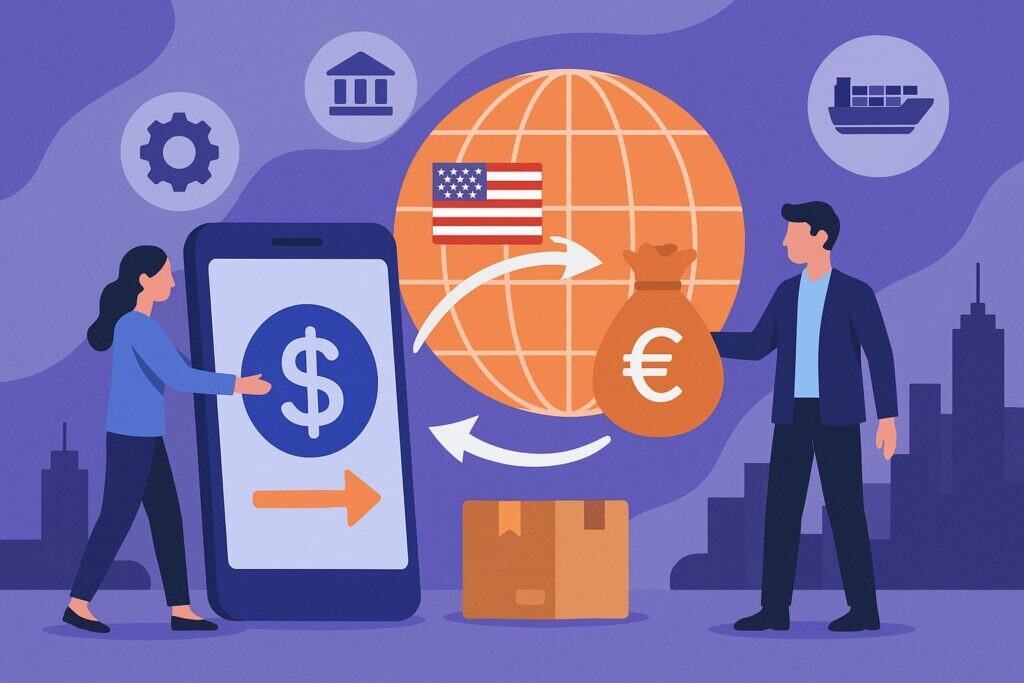
By crossborderfees September 25, 2025
International cross-border payment methods are critical for US businesses of all sizes, as companies look to expand globally. With global B2B cross-border flows exceeding $31 trillion in 2024 and projected to reach $50 trillion by 2032, choosing the right payment solutions can significantly impact costs, speed, and efficiency.
The best cross-border payment methods for businesses in 2025 will balance affordability, speed, and security while offering transparent currency conversion. This article explores the available options – from traditional banks to fintech platforms – and provides detailed comparisons on fees, speed, security, and other factors.
Why Cross-Border Payments Matter for US Businesses

As US companies expand globally, efficient international payment methods are essential. Cross-border business payments allow US firms to pay foreign suppliers, collect overseas sales, and manage global payroll.
In 2024 alone, banks handled about $27.8 trillion of the $30.2 trillion in global B2B cross-border payments (a 92% share). However, banks’ dominance is weaker in the SME segment: they covered only 76% of SME cross-border payments in 2023. (SMEs generated about 43% of all cross-border business transactions in 2023.)
The global market for cross-border business payments is enormous and growing. FXC Intelligence reports the worldwide B2B cross-border market was $31.6 trillion in 2024, forecast to reach $50 trillion by 2032 at roughly 5.9% annual growth.
Large enterprises accounted for about $17.8 trillion of that in 2024, while small and medium businesses contributed $13.8 trillion. These figures underscore the scale of international trade and digital commerce. For US businesses, this means an increasing need for efficient global payment methods.
Despite the high volume, cross-border payments can be slow and costly. Traditional bank wires often take 2–5 business days, with each wire incurring a high fixed fee plus an opaque currency exchange markup.
These hidden costs and compliance checks (KYC/AML) create challenges for businesses. By 2025, companies seek solutions that reduce fees, speed up transfers, and improve transparency.
Modern cross-border payment platforms (fintechs, digital wallets, etc.) are responding by cutting costs, automating processes, and providing real-time tracking.
Traditional Bank Transfers and Payment Networks

Traditional banks remain a backbone for international business payments. US firms commonly use wire transfers through Fedwire or CHIPS (for USD) and correspondent SWIFT transfers (for other currencies).
SWIFT, the global financial messaging network, connects over 11,500 institutions in 200+ countries. In 2023, SWIFT processed 42 million messages daily; its GPI (Global Payments Innovation) service enabled end-to-end tracking for about 89% of cross-border transactions.
However, using banks for cross-border payments has trade-offs:
- Fees: U.S. banks typically charge fixed wire fees of $30–$50 for outgoing transfers and about $15 for incoming transfers.
For example, Bank of America and Wells Fargo each charge around $45 per international outgoing wire. On top of this, banks often add a hidden “FX margin” to the exchange rate.
Instead of the true mid-market rate, they may apply a markup (often 1–3%). In practice, sending $10,000 USD could cost $45 plus $150–$300 in exchange spread. - Speed: Traditional wire transfers can take 1–5 business days. A USD payment to Europe might arrive in 1–2 days, but transfers to less-banked regions or involving multiple intermediaries can take longer. SWIFT GPI has improved speed, but delays still happen due to time zones and verification steps.
- Coverage: The advantage of banks is near-universal reach. Through SWIFT, almost any country with a SWIFT code can receive funds.
Large USD transfers clear in real-time on Fedwire or CHIPS (the Clearing House system), ensuring fast domestic settlement. Outside major currencies, banks rely on correspondent networks, which may have limited hours or higher fees. - Security and Compliance: Bank transfers are very secure. They require KYC/AML screening for both sender and receiver and often use insured settlement systems (e.g. CLS Bank for FX).
This institutional security makes them reliable for large sums, though it offers less real-time visibility for the business initiating the transfer.
In summary, traditional bank wires and payment networks offer broad coverage and established security, but at the expense of higher costs and slower speeds. Large enterprises often use them for high-value transactions.
Small and medium businesses may find the fees and delays burdensome, which has driven demand for alternative cross-border payment methods.
Fintech and Digital Payment Solutions

New fintech providers have transformed cross-border business payments by offering online multi-currency accounts, local receiving solutions, and transparent pricing. Key players include Wise (formerly TransferWise), Payoneer, Revolut, Airwallex, Stripe, and others:
- Wise (TransferWise) – Known for transparency, Wise processed £104 billion (~$129.5 billion) in transfers in FY2023. Wise Business accounts can hold 50+ currencies and send to 40+ currency corridors.
Crucially, Wise uses the true mid-market exchange rate and charges a small fee: roughly 0.57% of the transfer plus a flat component.
For example, sending $10,000 USD to EUR might incur a ~$60 fee, compared to hundreds at a bank. Wise’s local accounts allow clients in Europe, UK, or Australia to pay a US business in local currency as if it were domestic. - Payoneer – Popular with freelancers, marketplaces, and SMEs. Payoneer provides receiving accounts in USD, EUR, GBP, JPY, AUD, and more, so overseas customers or marketplaces (Amazon, Fiverr, etc.) can pay as if to a local account.
US businesses can withdraw USD from their Payoneer account to a bank for a low fee (often flat $1.50 per $100 up to $50k/mo). Payoneer’s currency conversion fee ranges from about 0.5% to 3% depending on the transaction. Payoneer also issues corporate cards for business spending. - Revolut Business – Offers multi-currency accounts and prepaid cards. In the US, Revolut Business supports around 25 currencies. It provides mid-market FX rates up to a monthly limit, then charges 0.5% per excess exchange and 1% on weekends.
Revolut’s app is strong, with budgeting and expense management tools. However, some features like full corporate card programs are still rolling out in the US. - Airwallex – An “all-in-one” payments platform aimed at scaling companies. It supports 23+ currencies for inbound balances and 40+ for payments. Airwallex offers near-interbank FX rates (roughly +0.3–0.6% spread), and even free conversions for major currency pairs.
It integrates with local banking rails to settle payments (often in 1 day) and provides corporate cards, invoicing, and API integration. Airwallex is often used by businesses managing global collections and payables under one system. - Stripe (Cross-Border Payments) – Primarily an online payments gateway, Stripe can accept payments in 135+ currencies and deposit them to US bank accounts.
For cross-border payouts, Stripe charges a 1% currency conversion fee. While it doesn’t offer multi-currency wallets, Stripe’s global infrastructure benefits e-commerce businesses collecting payments worldwide. - Other Platforms: PayPal (with Xoom) and Wise compete on remittances; their fees are higher (3–4%+). Some corporate networks (Mastercard B2B Connect, RippleNet) target large enterprises. Blockchain-based systems (e.g. stablecoins) exist but remain niche for mainstream business use in 2025.
Fintech vs. Banks: Fintech providers typically excel in user experience, speed, and cost. They provide online dashboards, APIs, and customer support oriented to small businesses.
Banks still handle the bulk of large flows but have ceded ground in SMEs and standard B2B transactions. Often, businesses use both: e.g. fintech for routine payments and banks for exceptional cases.
When choosing a provider, US businesses should consider supported countries/currencies, the ability to hold multiple currencies, integration options, and support availability. The next section directly compares these options.
Comparing Fees, Speed, and Currency Conversion
Traditional bank wires often include hidden FX markups, making costs hard to predict. Modern providers promise real-time rate visibility and clear pricing. When evaluating cross-border payment methods, key criteria include fees, transfer speed, security, and currency conversion.
- Fees & Costs: Banks: High fixed fees plus opaque FX margins. U.S. banks charge ~$30–$50 per international wire. They often apply a 1–3% currency spread behind the scenes. Fintech: Generally lower.
For instance, Wise charges about 0.5–1% total (including a tiny fixed fee). Payoneer and Revolut charge roughly 1–3%. Stripe adds 1% on currency conversion.
PayPal’s fees (3–5%+ on cross-border payments) are comparatively high. In summary, fintech can cost 50–75% less than banks on the same transfer. - Speed: Banks: 1–5 business days commonly. SWIFT transfers can be slow across time zones. Fintech: Often 1 business day or faster. Services like Wise and Airwallex settle most payments within 24 hours using local banking networks.
In some corridors, it can be same-day. Real-time networks (e.g. SEPA Instant in Europe) and fintech rail networks are pushing toward instant global transfers. - Currency Conversion: Banks’ hidden markups increase costs. Fintech platforms usually use the mid-market rate (with a small fee).
For example, converting USD→EUR with Wise might cost ~0.5%, while a bank might effectively charge 1.5–2% via its rate. Companies that transfer currencies frequently can save significantly by choosing providers with true exchange rates. - Security & Transparency: Both banks and licensed fintechs are secure and regulated. Banks have long track records; fintechs use encryption and adhere to standards.
Importantly, fintechs offer end-to-end tracking (often via dashboards), whereas traditional wires require manual status checks.
In practice, fintech payment methods often deliver lower total costs and faster turnaround for routine international transactions. Large companies may negotiate lower bank fees or use treasury services, but many still benefit from multi-currency fintech accounts for smaller or more numerous payments.
Security and Compliance
All credible cross-border payment methods must comply with strict regulations:
- Regulatory Oversight: Banks and fintechs alike perform KYC (Know Your Customer) and AML (Anti-Money Laundering) checks. Each cross-border payment is screened against sanctions lists and fraud checks.
Fintech platforms typically hold money-transmitter licenses (e.g. FinCEN registration in the U.S.) and may use automated tools for compliance. - Data Security: Leading providers follow industry security standards. For example, many are PCI DSS and SOC 2 compliant, and they encrypt payment data in transit. They also segregate customer funds in protected accounts.
Businesses should verify that any provider (bank or fintech) is certified and insured, ensuring funds are safe even if the provider faces issues. - Fraud Protection: Cross-border payments are final (usually irrevocable). Providers often offer safeguards like multi-factor authentication, transaction limits, and alerts. Some fintechs offer optional insurance or guarantees (e.g. refund if a fraud occurs), though the details vary.
For US businesses, both banks and fintechs can be safe. Banks are subject to federal oversight; fintechs operate under similar laws.
The main difference is user control: fintech dashboards may allow businesses to set up team approvals or spend controls easily, whereas banks might require internal processes. In all cases, using well-known, regulated services is crucial.
Key Comparison of Methods
Below is a summary comparison of traditional bank transfers versus modern payment platforms:
- Costs: Banks – high fixed wire fees and FX markups. Fintech – low percentage fees, often using interbank FX.
- Speed: Banks – 2–5 days. Fintech – often 1 day or same-day.
- Coverage: Banks – near-global (via SWIFT). Fintech – wide but may lack certain exotic corridors or currencies.
- Transparency: Banks – fees and FX spread are often opaque. Fintech – all fees shown upfront.
- Integration: Banks – limited APIs (unless expensive treasury tools). Fintech – modern APIs and software integrations for automation.
- Support: Banks – phone/support desks; fintechs – app/chat support, sometimes 24/7 online help.
Key Features to Look For: The best cross-border payment methods in 2025 should offer:
- Competitive fees and clear FX rates: Ideally mid-market FX and a small fee.
- Fast delivery: Ability to send and receive funds in 1 business day or less.
- Real-time tracking: Online dashboard or tracking codes showing payment status.
- Strong security: PCI DSS / SOC 2 compliance and rigorous KYC/AML.
- Integration: API or accounting integrations for bulk payments.
- Local support: Customer service in relevant time zones.
Providers meeting these criteria (e.g. multi-currency fintech accounts, global payment networks) will likely be the most efficient and user-friendly solutions.
Solutions for SMEs vs. Large Enterprises
- SMEs (Small Businesses): Cost and ease-of-use are paramount. Many SMEs adopt fintech solutions because of low or no setup fees and clear pricing. For example, a small import/export firm might use Wise Business to pay overseas suppliers with minimal fees.
An online seller might use Payoneer to receive Amazon payments in USD/EUR and then pay international vendors from that balance. Multi-currency accounts let SMEs avoid multiple bank setups and simplify receivables. - Large Enterprises: High volume and integration matter. Large firms often use a mix of methods. They maintain bank relationships for very large or urgent transfers, but also use fintech rails to cut costs on smaller, routine transactions.
For instance, a multinational may use an automated platform (or an “in-house bank”) to net internal payables/receivables across subsidiaries, minimizing FX conversions. They may also use forex forward contracts (through banks) to hedge risk.
Corporations prioritize reliability and compliance, often deploying customized solutions or paying for premium banking services.
In short, SMEs often lean heavily on digital multi-currency platforms, while large enterprises blend banks and fintech. Both should analyze transaction sizes, currencies, and integration needs to choose the optimal mix.
Future Trends (2025 and Beyond)
Cross-border payments are evolving rapidly. Some emerging trends:
- Instant and Real-Time Transfers: The adoption of ISO 20022 messaging and new real-time payment rails (e.g. FedNow in the US, extended SWIFT gpi) will make instant or same-day global transfers more common. By 2025, payments could approach the speed of domestic ACH/instant systems.
- Digital Currencies: Central bank digital currencies (CBDCs) and stablecoins have potential to speed settlement and lower costs. Several countries (e.g. China’s digital yuan) are piloting CBDCs.
Though the US has paused a retail CBDC, future “digital dollar” use cases (especially for wholesale transactions) could reshape cross-border flows. Private stablecoins (e.g. USD Coin) are already used by some businesses for quick transfers, hinting at further integration. - Blockchain and DLT: Distributed ledger networks (RippleNet, Stellar, etc.) continue to improve cross-border rails. While not mainstream for most US businesses by 2025, they pressure traditional systems to innovate. Over time, banks and fintechs may interconnect with blockchain solutions for settlement.
- AI and Automation: Machine learning will optimize FX trading and detect fraud in real time. Smart contracts could automate payments on invoice approval. Greater automation will reduce manual reconciliation and compliance work.
- Embedded Finance: Cross-border payment features are increasingly built into non-financial platforms (ERP systems, e-commerce platforms, procurement software).
For example, global ERP suites might offer one-click international disbursements, using partnered payment providers behind the scenes.
Given these trends, businesses in 2025 should expect more options for fast, transparent cross-border payments.
Providers combining multiple rails (SWIFT, real-time networks, blockchain) under one platform will lead the way. US businesses should stay informed about emerging methods and remain flexible in adopting new payment channels.
FAQs
Q.1: What is the cheapest way to pay a supplier overseas?
Answer: Using a reputable digital transfer service (like Wise or Payoneer) is usually cheapest. These use the real market exchange rate and charge low upfront fees. Banks, by contrast, add hidden FX markups.
Q.2: How fast are cross-border payments?
Answer: It depends on the method. Banks typically take 1–5 business days. Modern fintech methods often settle in 1 business day or less. Some corridors even allow near-instant transfers.
Q.3: Can I reduce cross-border fees?
Answer: Yes. Strategies include batching payments (to minimize fixed fees), using local currency accounts, and choosing providers with transparent, low FX margins. Avoid paying by credit card or PayPal (they have higher fees for large transfers).
Q.4: Are fintech payment platforms safe?
Answer: Reputable fintechs are regulated and secure. They follow strict KYC/AML rules and security standards (PCI DSS, SOC 2). They also hold customer funds in protected accounts. Always verify a provider’s regulatory status before use.
Q.5: Do I still need a bank for international payments?
Answer: For most SMB transactions, fintech platforms suffice. However, many businesses keep a bank account for certain use-cases (very large amounts, specific currencies, or regulatory reasons). In practice, companies often use both banks and fintechs.
Q.6: What about using cryptocurrency?
Answer: Cryptocurrency and stablecoins (like USDC) can move money instantly across borders, but they are not yet common for typical business payments due to volatility (for crypto) and regulatory uncertainty. They remain niche in 2025 for most companies.
Conclusion
By 2025, US businesses have a wide array of cross-border payment methods. Traditional bank wires (Fedwire, CHIPS, SWIFT) still handle the majority of large transfers, but they carry high fees and slower speeds.
Fintech payment solutions like Wise, Payoneer, Revolut, and Airwallex offer powerful alternatives with lower costs, transparent exchange rates, and faster settlement. Small and medium enterprises often find fintech solutions the most cost-effective for routine international transactions.
Large enterprises may adopt a hybrid approach – using banks for high-value payments and fintech platforms for agility and cost savings. The key is to evaluate options based on one’s transaction volume, required currencies, and integration needs.
Ultimately, the best cross-border payment method depends on each business’s context. By 2025, companies should leverage the strengths of both banks and fintech: use banks where trust and scale are needed, and fintech where efficiency and cost matter.
As global payment technologies advance, those who choose the optimal mix of payment rails will keep money moving efficiently across borders.